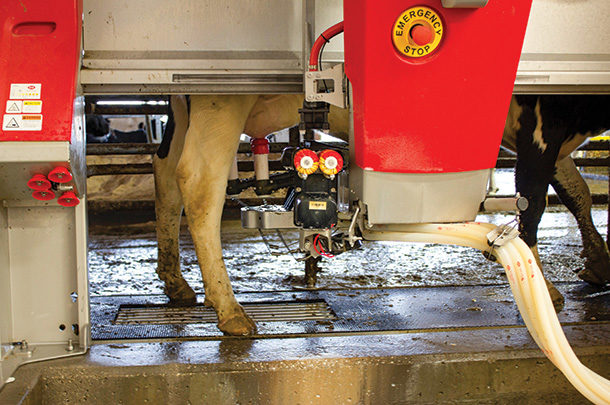Ten minutes a day will keep robot issues away. Proper daily maintenance routines are vital for robot owners who don’t want the robot calling in the middle of the night. Here is a list of items to check when you enter the robot room.
- To get the most out of a milking robot, one of the most important tasks is to clean it on a daily basis, even multiple times a day. The use of good-quality water and correct cleaning tools in and around the robot is very important to ensure it will continue running well.
- Wash and clean the robot before maintenance. Before replacing or repairing something, first wash the exterior of the robot and rinse with cold water. In particular, wash the areas you want to inspect, including the teat detection system, teat cups, cup cords and twin tubes. This ensures you can work more easily and hygienically.
- Observe the robot wash cycle. Are the brushes getting solution and operating properly? Is the cluster wash cycling properly from prerinse, main wash to post rinse? Check jetter alignment and nozzles as well as gaskets and fittings. Remember to also check chemical supply hoses and barrels to ensure chemicals are dispensing properly.
- Finally, observe the post-dip spray. Check that the spray is hitting the teats and coverage is adequate. Do one final check to ensure the supply hoses don't have kinks or wear and that containers have adequate supply.
- Clean the teat-detection system and 3D camera for proper connection. A clear field of vision is critical. Keeping these components clean will help reduce connection issues. Use a soft, moist towel with a small quantity of lens cleaner liquid to clean the teat detection screen and 3D camera.
- Replace liners after 10,000 milkings. You are advised to replace silicone liners after 10,000 milkings. For Lely owners, an alert is set for when it is time to replace these; just remember to reset the alert after replacing them. Changing the liners becomes an easy job when you use the specially designed tool. If you do not have access to this tool, consult your local distribution center.
- Clean bleed hole with provided bleed-hole needle. A clean bleed hole is crucial for optimal milking and milk transport to the milk jar. If it’s blocked, it causes reduced milk flow, which will result in a slower cup take-off and incorrect milking on one or more quarters. A higher dead milk time (DMT) may even occur, with increased connection attempts and failures as a result. It’s best to clean the bleed holes twice a day. In addition to this check, please check the twin tubes visually for cracks and/or other damage.
- Check duplo covers. Duplo covers prevent teat cups from getting tangled and/or cracked, which may cause a critical alarm. Although duplo covers are made of solid plastic, some maintenance by cleaning is important. Any dirt and/or other contamination buildup in this area is a potential risk for bacteria growth.
For more information, consult your operator’s manual for the full recommended list of cleaning tasks. As always, remember safety first and wear proper personal protective equipment when working with chemicals and robots.







